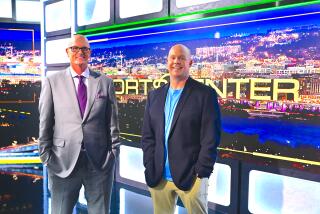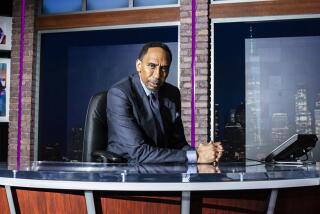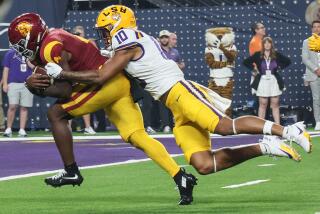The Watchword Is Entertainment
It’s an update of the classic Horatio Alger plot: George Bodenheimer takes a job in the mail room of a daring, young company in his home state of Connecticut in 1981 and 17 years later, he’s appointed president of ESPN Inc., having helped make the fledgling network an integral part of the nation’s sports culture.
As the Entertainment and Sports Programming Network, ESPN has grown mightily under his direction. Among his key recent accomplishments was starting an entertainment arm to produce made-for-TV movies and TV shows, and acquiring the broadcast rights to the NBA for $2.4 billion. ESPN’s reach extends to 150 countries. Last month was its most-viewed June. The same was true for ESPN2, which also had its most-viewed quarter.
Bodenheimer, 44, was in Los Angeles for tonight’s ESPY awards, which recognize individual and team excellence in sports. The live, 6 p.m. telecast from the Kodak Theatre in Hollywood will be the first on the West Coast after seven years in New York and two in Las Vegas. The ESPYs have raised $24 million for cancer research in conjunction with the V Foundation, named for Jim Valvano, the late basketball coach. Thirty-five awards will be handed out, among them a new one for best disabled athlete.
Early this week, Bodenheimer sat for a wide-ranging interview on his company:
Question: What was behind the decision to move the ESPYs here?
Answer: We like to move our events around at ESPN. The X Games is a good example, and the ESPYs as well. Our presence in Los Angeles has been increasing, what with our ownership by Disney [80% of ESPN is owned by ABC Inc., a subsidiary of the Walt Disney Company]. We have an ESPN Zone down in Anaheim, and the ESPYs are here. We like to increase our West Coast presence.
Q: How do you keep the ESPYs distinctive in a landscape filled with so many events, awards and awards shows?
A: We think the ESPYs are unique in terms of being a blend of sports and entertainment. You’ll see as many Hollywood stars as you’ll see athletes, and that’s what we think makes for a unique show. It adds some juice to what we’re doing. Many times, athletes say they want to meet and be the entertainers, and the entertainers say their dream is to be a professional athlete. Putting them together makes for an entertaining evening for us.
What we’re trying to do is trying not to make this ESPN’s night. We’re trying to make this an evening for the entire sports industry to celebrate sports.... The V Foundation will again be a significant beneficiary of the evening, and we’re proud of that. It seems like cancer has touched every family in America, and ESPN and the V Foundation are working hard to fulfill Jim’s vision to do something about it. That’s good.
Q: How do you see the ESPYs fitting in with your target audience? And what do you consider to be your target audience?
A: Sports fans generally, in the ages of 18 to 49, is where our bread is buttered, so to speak. We have both younger viewers and older beyond that. That’s really our core. It’s 70% male and 30% female.
Q: On other networks, there seems to be a trend toward sports-talk shows that feature a lot of yelling and bullying, seemingly catering to a young male audience. Do you see a need to do that? Is there a place for that?
A: At ESPN, we don’t feel the need to necessarily copy anybody. We’re always trying to evolve what we do. We’ve been on the air nearly 23 years, and if you look at our history over 23 years, we have evolved our programming quite a bit. We have launched a new group in the company, ESPN Original Entertainment, under the banner of which the film “Season on the Brink” was produced, as well as a hit show we have now, “Pardon the Interruption,” with [Washington Post sportswriters] Tony Kornheiser and Mike Wilbon.
Do I think there’s room for sports entertainment? Yes, I certainly do, and ESPN is certainly headed in that direction. We certainly don’t define that as putting people on the air that yell at each other. We’ve always thought of it, and we cite this often at ESPN, we take our sports seriously but we don’t take ourselves too seriously. That’s really become a company mantra that, I think, comes through to our fans. Things like [Monday’s] home run hitting contest and [Tuesday’s] All-Star game, we live for things like that. Sports is great theater. But at the same time, we like to have fun, and I think people tune to ESPN because they like that attitude and they like to have fun. We try to deliver that.
Q: In the time you’ve been at ESPN, there have been a number of innovations and a good deal of evolution, the latest being the NBA contract. How does the NBA fit in with your existing NHL contract and with your programming in general?
A: The NBA was a very significant acquisition for us in that when a property like the NBA becomes available and you’re in the sports business, you work as hard as you can to acquire that. It marks a great milestone for us and any TV network because it’s the first time any one network has had all four major professional sports under contract at one time. We’re proud of that. We think that will deliver good diversity for our fan base. As far as hockey [goes], we’re still as committed as ever to hockey. We had a very good year this year and ESPN enjoys a close relationship with the league office and we’re going to continue our feature presentations of hockey.
Q: Did the NHL express concern that it might be shunted aside or become a secondary event for you?
A: All leagues, to their credit, work hard to serve their interests, and hockey’s no different. But no, I don’t think there’s concern. In fact, the NBA provides a great promotional vehicle for hockey.
Q: Can viewers expect to see ESPN expand its NBA programming beyond the game telecasts?
A: In addition to “Inside Stuff,” we’re also going to be adding pregame shows and additional analysis.... We also have the contract for ESPN Radio. ESPN really has a multi-face to it now. We have the largest sports radio network in the country. We broadcast NBA and baseball games, to name two. And we have ESPN.com and ESPN The Magazine, in addition to four TV networks [ESPN, ESPN2, ESPN Classic and ESPNEWS]. One of the things I like about the NBA deal is, the deal will benefit all of those media, and that’s the kind of business relationship ESPN will look for in its league partners. In effect, there’s something for every one of our businesses in this deal.
Q: How do you assess ESPN’s World Cup telecasts, and do you expect the World Cup to provide a bump for your MLS ratings?
A: Relative to the World Cup, we were very pleased with the ratings and the excitement the World Cup delivered. [ESPN’s 24 live telecasts reached 963,000 households, up 39% from 1998, and 34 live telecasts on ESPN2 reached 490,000 households, up 52% from 1998.] It was a great success and it was exciting to see the U.S. run [to the quarterfinals], which generates the bulk of that excitement. But it also showcased some of the fine MLS players, which I think will lead to a bump in MLS ratings. There’s clearly a growing soccer movement in the U.S. Everyone involved in soccer would like it to be faster and bigger, but reality is, it’s growing, and the World Cup effort will only continue to serve to support that growth.
Q: Can you envision soccer reaching a par with the NHL or NBA or other major sports?
A: I would never say never about anything, but I think one thing ESPN has demonstrated is, there is a market for fans of virtually every sport out there. We televise roughly 65 different sports.... I think soccer can certainly establish a foothold, no pun intended, in this country.
Q: Was carrying WNBA games part of the NBA deal?
A: We’ve had the WNBA for six years and we just re-upped with the WNBA as part of the most significant commitment to women’s sports out there. Between the WNBA, the women’s U.S. soccer team, the LPGA and the NCAA women’s basketball tournament, which we’re going to televise all 63 games of next year, it’s part of a huge commitment to women’s sports that I don’t think is equaled anywhere in television.
Q: There has been talk of a baseball strike, although players didn’t take a strike vote [Monday]. What effects would you anticipate a baseball strike would have on ESPN in particular and baseball in general?
A: I would not care to speculate much on that. There are sensitive negotiations now and, frankly, it’s their business to conclude. Obviously, we’re in business to televise games, and if there are no games, that’s not a positive development. We’re very hopeful players and management will work out their differences.
Q: Have you come up with alternative programming in case there is a strike?
A: No. We’ll get to that if need be. Right now we’re optimistic.
Q: How have your baseball ratings been?
A: Ratings are up. We’re having a very good year with baseball. [Ratings for Sunday and Wednesday games are up 15%, ratings for Monday and afternoon games are up 50%, compared to the same time period a year ago, and ESPN2’s ratings are up 43%.]
Q: Do you have in mind ratings numbers you’d like to see for your NBA games?
A: We do, but I’m not going to cite a public number because it will just set up an expectation. We are looking for increased ratings and we think having the games on ESPN, which is a network devoted to sports, will provide us a good opportunity to grow the sport.
Q: You spoke before about the various businesses that ESPN has gotten into. What’s next?
A: Growth through technology, perhaps video-on-demand applications, some interactive TV applications. We’re developing new programming and adding new types of programming. [Tuesday’s announcement of a second made-for-TV movie, “The Junction Boys,” based on a book by Jim Dent about a Bear Bryant summer football camp] that’s an example of how ESPN is evolving....
If you look at our 23 years, we basically made ESPN what it is today on two prongs of a stool. One is games, events. Winners, losers, whistles, referees and stuff. The other is sports-news shows, with our flagship “SportsCenter,” then “NBA 2Night,” “NHL 2Night,” all the news shows. Now, we believe there is room for a third prong, sports entertainment. So we formed ESPN Original Entertainment and we’re producing movies, game shows and, potentially, dramas. We know that our fans will accept this from ESPN as long as it stays true to our core of authentic sports.
Q: There’s also ESPN Spanish-language programming [showing baseball, the NFL and some boxing]. What’s your vision for the eventual scope of that?
A: ESPN Deportes is in 12 million homes, which is most of the significant Hispanic markets in the U.S.... It’s a bloc of programming on Sunday nights, but we’re looking to expand that to 24 hours, seven days a week. We haven’t concluded our planning on that but it’s something we’re considering.
Q: You’ve come a long way from the mail room.
A: This is a great company that has a fabulous culture. ESPN is a company marked by a can-do attitude.... You’ve got to remember, for a lot of years, nobody in the mainstream media took us very seriously, and we weren’t on anybody’s radar screens. We developed an esprit de corps and just kept improving what we were doing. We knew we were onto something because of the reaction of fans. We knew fans wanted more and, quietly, we delivered it. We stuck to it.
The first program on ESPN the first night we were on the air [Sept. 7, 1979] was “SportsCenter.” Now, 23 years later “SportsCenter” is itself a brand, and it’s our flagship program. It’s the daily record for sports. But there was a lot of hard work getting there. Athletes now ask, “Is this a ‘SportsCenter’ highlight?” and that’s the ultimate sign of respect from athletes.
Q: There was a flap when Dan Patrick, one of your personalities, appeared in commercials for Coors. What is your position on that?
A: You’ve got to look at opportunities on a case-by-case basis and we make decisions that we deem are in our best interests.... We thought it appropriate at the time, and we stand by our decision.
Q: Has Disney’s acquisition of ESPN changed the network’s operations?
A: Disney’s acquisition of ESPN has been very good for the company. Many of our expansions have been born under the Disney ownership. ESPN The Magazine, which is a thriving business, is probably the best example. Disney is obviously one of the quintessential marketing companies in the world and adding that expertise to our brand has clearly catapulted the growth of this company.
Q: What happened to plans for an ESPN West?
A: We contemplated that and ultimately decided to stick to our knitting and stick with national networks, as opposed to regional ones. It’s complicated, launching a network. Our bread and butter is national networks.
More to Read
Go beyond the scoreboard
Get the latest on L.A.'s teams in the daily Sports Report newsletter.
You may occasionally receive promotional content from the Los Angeles Times.











